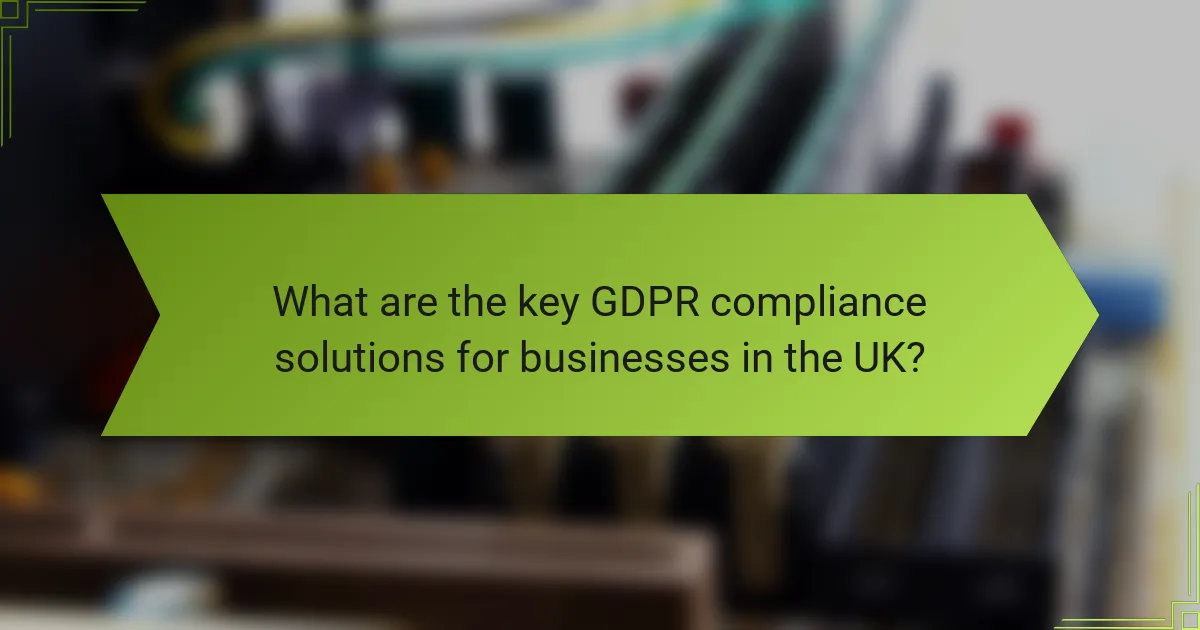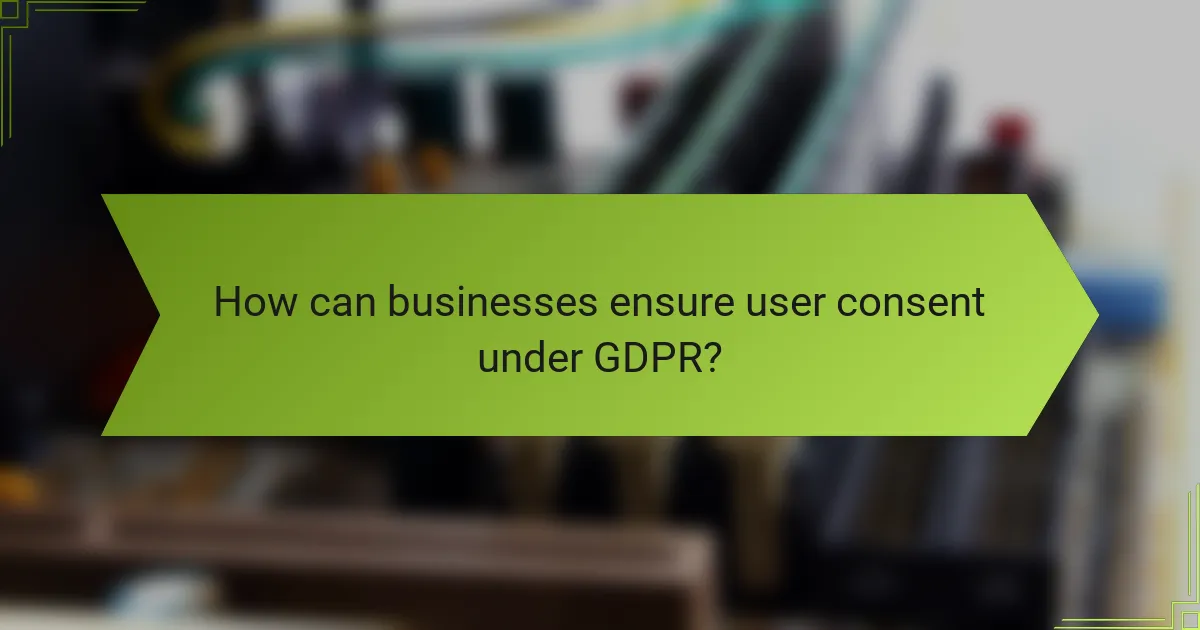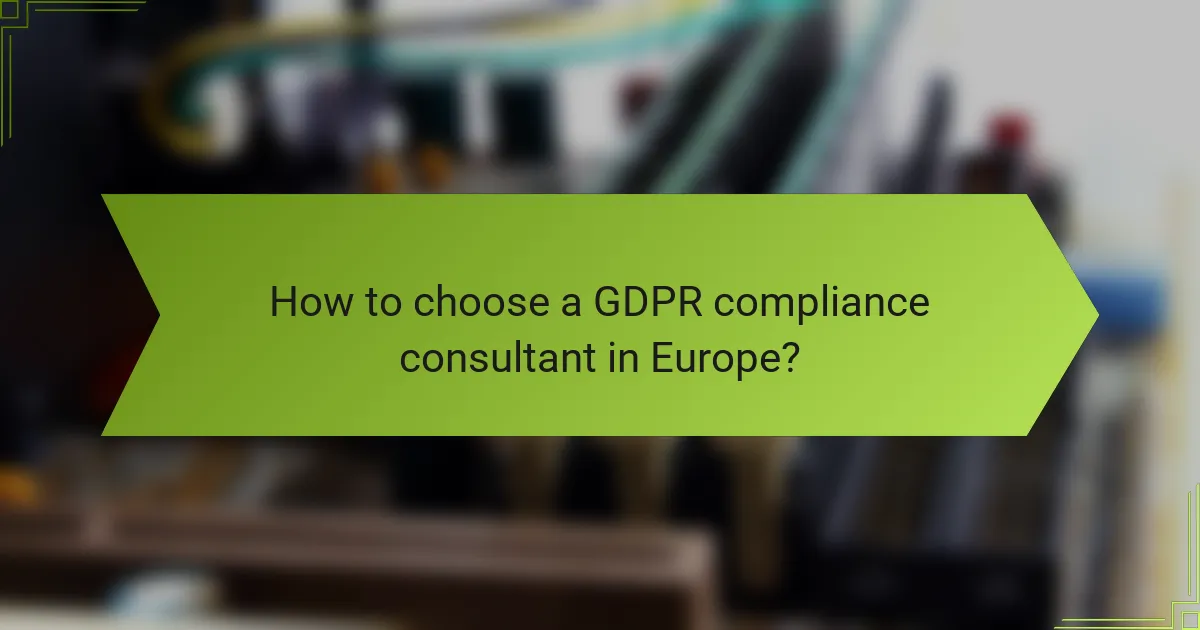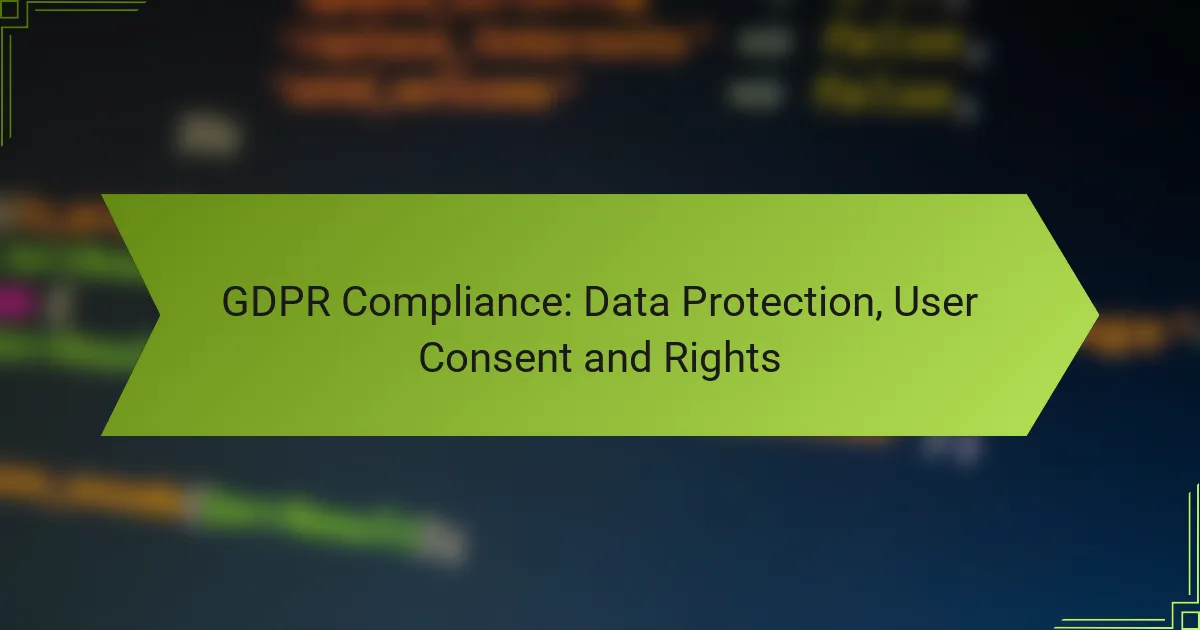The General Data Protection Regulation (GDPR) establishes essential guidelines for businesses in the UK to manage personal data responsibly. Key compliance solutions include implementing user consent management tools and updating privacy policies to ensure transparency. Additionally, GDPR empowers users with rights such as data access, deletion, and transfer, enhancing their control over personal information.

What are the key GDPR compliance solutions for businesses in the UK?
Key GDPR compliance solutions for businesses in the UK include implementing data protection impact assessments, user consent management tools, privacy policy updates, employee training programs, and data breach response plans. These solutions help ensure that organizations handle personal data responsibly and in accordance with GDPR regulations.
Data Protection Impact Assessments
Data protection impact assessments (DPIAs) are essential for identifying and mitigating risks associated with data processing activities. Businesses should conduct DPIAs when initiating new projects that involve personal data to evaluate potential impacts on privacy.
A practical approach involves mapping data flows, assessing risks, and documenting measures taken to address those risks. Regular reviews of DPIAs can help maintain compliance as business practices evolve.
User Consent Management Tools
User consent management tools are vital for obtaining and managing consent from individuals whose data is being processed. These tools should allow users to easily give, withdraw, or modify their consent preferences.
Implementing a clear consent mechanism, such as checkboxes or pop-ups, ensures transparency. It’s crucial to keep records of consent to demonstrate compliance during audits or inspections.
Privacy Policy Updates
Regular updates to privacy policies are necessary to reflect current data processing activities and comply with GDPR requirements. A well-structured privacy policy should clearly inform users about how their data is collected, used, and shared.
Businesses should ensure that privacy policies are easily accessible and written in plain language. Regular reviews and updates should coincide with changes in data processing practices or regulations.
Employee Training Programs
Employee training programs are critical for fostering a culture of data protection within an organization. Training should cover GDPR principles, data handling best practices, and the importance of safeguarding personal information.
Regular training sessions and updates can help employees stay informed about compliance requirements. Consider using interactive formats, such as workshops or e-learning modules, to enhance engagement and retention of information.
Data Breach Response Plans
A robust data breach response plan is essential for minimizing the impact of any data breaches that may occur. This plan should outline specific steps for identifying, reporting, and managing breaches in compliance with GDPR timelines.
Key components of a response plan include assigning roles and responsibilities, establishing communication protocols, and conducting regular drills to ensure readiness. Businesses should also keep a record of breaches and responses to demonstrate compliance and improve future practices.

How can businesses ensure user consent under GDPR?
Businesses can ensure user consent under GDPR by implementing clear and transparent mechanisms that allow users to provide explicit agreement for data processing. This involves using straightforward language and providing users with the necessary information about how their data will be used.
Explicit Consent Mechanisms
Explicit consent mechanisms require businesses to obtain clear and affirmative consent from users before collecting or processing their personal data. This can be achieved through checkboxes, toggle switches, or dedicated consent forms that clearly outline what users are consenting to.
For example, a website might use a checkbox that states, “I agree to the processing of my personal data for marketing purposes.” This ensures that consent is not implied but rather actively given by the user.
Granular Consent Options
Granular consent options allow users to choose which specific types of data processing they consent to, rather than providing blanket consent. This means users can agree to some uses of their data while refusing others, such as opting in for newsletters but opting out of targeted advertising.
Providing granular options can enhance user trust and satisfaction, as it gives them more control over their personal information. Businesses should clearly list the different purposes for data processing and allow users to customize their preferences easily.
Consent Withdrawal Procedures
GDPR mandates that users must be able to withdraw their consent at any time, and businesses should have clear procedures in place for this. This can include providing an easily accessible option on websites or apps where users can manage their consent preferences.
For instance, a user should be able to click a link in an email or visit their account settings to revoke consent for data processing. Businesses should ensure that the withdrawal process is as simple as giving consent, reinforcing a user-friendly approach to data protection.

What rights do users have under GDPR?
Under the General Data Protection Regulation (GDPR), users have several key rights that empower them to control their personal data. These rights include the ability to access their data, request its deletion, and transfer it to other services, ensuring transparency and user autonomy in data handling.
Right to Access
The Right to Access allows individuals to request confirmation from organizations about whether their personal data is being processed. Users can obtain a copy of their data along with details about how it is used, the purpose of processing, and the retention period.
To exercise this right, users typically need to submit a formal request to the organization, which must respond within one month. Organizations may charge a fee for excessive requests, but this is usually limited to administrative costs.
Right to Erasure
The Right to Erasure, often referred to as the “right to be forgotten,” enables users to request the deletion of their personal data under certain conditions. This right applies when the data is no longer necessary for the purposes for which it was collected or if the user withdraws consent.
Organizations must comply with such requests unless they have a legitimate reason to retain the data, such as legal obligations. Users should clearly state their reasons for requesting erasure to facilitate the process.
Right to Data Portability
The Right to Data Portability allows users to obtain their personal data in a structured, commonly used, and machine-readable format. This right facilitates the transfer of data from one service provider to another, enhancing user control over their information.
To utilize this right, users should ensure that their data is being processed based on consent or a contract. Organizations are required to provide the data without hindrance, typically within one month of the request.

What are the penalties for non-compliance with GDPR?
The penalties for non-compliance with GDPR can be severe, including significant fines, reputational harm, and potential legal actions from affected users. Organizations must prioritize adherence to GDPR to avoid these consequences.
Fines up to €20 million
GDPR allows for fines that can reach up to €20 million or 4% of a company’s global annual revenue, whichever is higher. This tiered approach means that larger organizations could face substantial financial penalties for violations, making compliance critical.
Fines are determined based on various factors, including the nature of the infringement, the number of affected individuals, and whether the violation was intentional or due to negligence. Companies should regularly assess their data protection practices to mitigate the risk of incurring such fines.
Reputational Damage
Non-compliance with GDPR can lead to significant reputational damage, impacting customer trust and brand loyalty. Organizations that face public scrutiny due to data breaches or regulatory actions may find it challenging to recover their standing in the market.
Maintaining a strong reputation is crucial for business success, and compliance with GDPR is a key component of building and preserving that reputation. Companies should communicate their commitment to data protection transparently to reassure customers.
Legal Actions from Users
Users have the right to take legal action against organizations that fail to comply with GDPR. This can include seeking compensation for damages resulting from data breaches or mishandling of personal information.
Organizations should be aware that legal actions can lead to costly settlements and further damage their reputation. Implementing robust data protection measures and ensuring user consent can help minimize the risk of legal challenges from users.

What are the prerequisites for GDPR compliance?
To achieve GDPR compliance, organizations must establish a clear understanding of their data processing activities, ensure user consent is obtained, and respect the rights of individuals regarding their personal data. Key prerequisites include maintaining a comprehensive data inventory, conducting risk assessments, and implementing appropriate security measures.
Data Inventory and Mapping
A data inventory is a detailed record of all personal data processed by an organization. This includes identifying what data is collected, where it is stored, how it is used, and who has access to it. Mapping data flows helps visualize how data moves within the organization and to third parties, which is essential for compliance.
Organizations should regularly update their data inventory to reflect changes in processing activities. A practical approach is to categorize data by type, such as customer information, employee records, and marketing data, which aids in identifying risks and compliance gaps.
Risk Assessment Frameworks
Implementing a risk assessment framework is crucial for identifying potential vulnerabilities in data processing activities. This involves evaluating the likelihood and impact of data breaches or non-compliance incidents. Common frameworks include the ISO 27001 standard and the NIST Cybersecurity Framework, which provide structured approaches to risk management.
Organizations should conduct regular risk assessments and document findings to demonstrate compliance efforts. A useful practice is to prioritize risks based on their potential impact on individuals’ rights and freedoms, ensuring that the most significant risks are addressed promptly.

How to choose a GDPR compliance consultant in Europe?
Selecting a GDPR compliance consultant in Europe requires careful consideration of their expertise, experience, and understanding of local regulations. Look for consultants who have a proven track record in data protection and can tailor their services to your specific business needs.
Evaluate their expertise in GDPR regulations
When assessing a consultant’s expertise in GDPR, check their qualifications and certifications related to data protection. Look for professionals who have experience working with organizations similar to yours, as they will better understand your unique challenges.
Additionally, inquire about their familiarity with the specific GDPR requirements that apply to your industry. This ensures they can provide relevant advice and practical solutions tailored to your business context.
Assess their experience with data protection strategies
Experience in implementing data protection strategies is crucial. A consultant should demonstrate a history of successful projects, including risk assessments, data audits, and compliance frameworks. Ask for case studies or references to gauge their effectiveness.
Consider their approach to developing customized compliance plans. A good consultant will not only help you meet legal obligations but also enhance your overall data governance and security posture.
Check their understanding of user consent and rights
A strong GDPR consultant should have a deep understanding of user consent mechanisms and individual rights under the regulation. This includes knowledge of how to obtain, manage, and document consent effectively.
Ensure they can guide you on how to implement processes that respect user rights, such as data access, rectification, and erasure requests. Their ability to educate your team on these aspects is also vital for maintaining ongoing compliance.
Consider their communication and support style
Effective communication is key when working with a GDPR compliance consultant. Look for someone who can explain complex legal concepts in simple terms and is responsive to your questions and concerns.
Evaluate their support structure. A consultant who offers ongoing support and training can help your organization adapt to changing regulations and maintain compliance over time.
